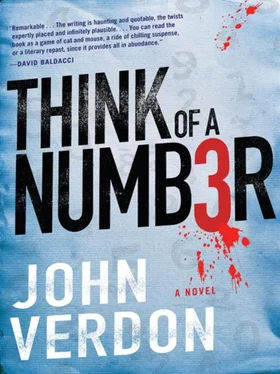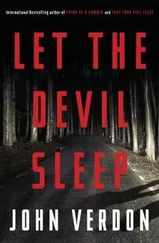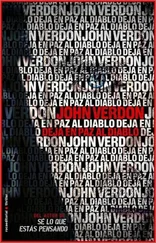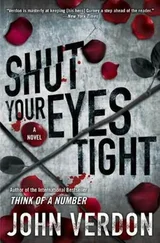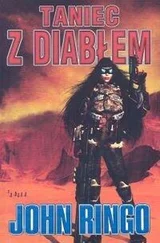Kline cast her an assessing glance. Unlike Rodriguez, mused Gurney, he was intelligent enough to respect intelligence.
Rodriguez made an effort to retake the reins. “What caliber bullet are we looking for, Doctor?”
Thrasher glared over the top of the half-glasses that were making their way down his long nose. “What do I have to do to get you people to grasp the simplest facts of pathology?”
“I know, I know,” said Rodriguez peevishly, “the flesh is pliable, it shrinks, it expands, you can’t be exact, et cetera, et cetera. But would you say it was closer to a.22 or a.44? Make an educated guess.”
“I’m not paid to guess. Besides, no one remembers for more than five minutes that it was only a guess. What they remember is that the ME said something about a.22 and he turned out to be wrong.” There was a cold gleam of recollection in his eyes, but all he said was, “When you dig the bullet out of the back of the house and give it to ballistics, then you’ll know-”
“Doctor,” interrupted Kline like a little boy questioning Mr. Wizard, “is it possible to estimate the exact interval between the gunshot and the subsequent stabbings?”
The tone of the question seemed to mollify Thrasher. “If the interval between the two were substantial, and both wounds bled, we would find blood in two different stages of coagulation. In this case I would say that that the two types of wounds occurred in close enough sequence to make that sort of comparison impossible. All we can say is that the interval was relatively short, but whether it was ten seconds or ten minutes would be hard to say. That’s a good pathology question, though,” he concluded, distinguishing it from the captain’s question.
The captain’s mouth twitched. “If that’s all you have for us at the moment, Doctor, we won’t keep you. I’ll get the written report no later than one week from today?”
“I believe that’s what I said.” Thrasher picked up his bulging case from the table, nodded to the district attorney with a thin-lipped smile, and left the room.
Without a trace
“There goes one pathological pain in the ass,” said Rodriguez, surveying the faces at the table for appreciation of his wit in so describing a pathologist, but only the perennial smirks of the twin Cruises came close to providing it. Kline ended the silence by asking Hardwick to continue the crime-scene narrative he’d been providing when the ME arrived.
“Exactly what I was thinking, Sheridan,” Rodriguez chimed in. “Hardwick, pick up where you left off, and stay with the key facts.” The warning suggested that this was not something Hardwick normally did.
Gurney noted the predictability of the captain’s attitudes-hostile to Hardwick, sycophantic to Kline, self-important in general.
Hardwick spoke rapidly. “The most visible trace of the murderer was a set of footprints, entering the property through the front gate, proceeding through the parking area around to the rear of the barn, where they stopped at a lawn chair-”
“In the snow?” asked Kline.
“Correct. Cigarette butts were found on the ground in front of the chair.”
“Seven,” said the redhead at the laptop.
“Seven,” repeated Hardwick. “The footprints proceed from the chair-”
“Excuse me, Detective, but did the Mellerys normally keep lawn chairs out in the snow?” asked Kline.
“No, sir. It appears that the murderer brought the chair with him.”
“Brought it with him?”
Hardwick shrugged.
Kline shook his head. “Sorry to interrupt you. Go ahead.”
“Don’t be sorry, Sheridan. Ask him anything you want. A lot of this stuff doesn’t make sense to me, either,” said Rodriguez, with a look that attributed the lack of sense to Hardwick.
“The footprints proceed from the chair to the location of the encounter with the victim.”
“The spot where Mellery was killed, you mean?” asked Kline.
“Yes, sir. And from there they proceed through an opening in the hedge, out across the lawn, and into the woods, where they finally terminate half a mile from the house.”
“How do you mean, ‘terminate’?”
“They stop. They go no farther. There is a small area there where the snow is tamped down, as if the individual was standing there for a while-but no more footprints, either coming to or leaving that spot. As you heard a little while ago, the boots that made the prints were found hanging in a nearby tree-with no sign of what happened to the individual who was wearing them.”
Gurney was watching Kline’s face and saw there a combination of bafflement at the puzzle and surprise at his inability to see any solution. Hardwick was opening his mouth to press forward when the redhead spoke again in her quiet, uninflected voice, perfectly pitched halfway between male and female.
“At this point we should say the sole patterns of the boots are consistent with the prints in the snow. Whether, in fact, they made the prints will be determined in the lab.”
“You can be that definite with footprints in snow?” asked Kline.
“Oh, yes,” she said with her first bit of enthusiasm. “Snow prints are the best of all. Compressed snow can capture details too fine to see with the naked eye. Never kill anyone in the snow.”
“I’ll remember that,” said Kline. “Sorry again for the interruption, Detective. Please go on.”
“This might be a good time for a status report on items of evidence collected so far. If that’s all right with you, Captain?” Again Hardwick’s tone struck Gurney as a subtle mockery of respect.
“I’d welcome some hard facts,” said Rodriguez.
“Let me just bring the file up,” said the redhead, stroking a few keys on her computer. “You want the items in any particular order?”
“How about order of importance?”
Showing no reaction to the captain’s patronizing tone, she began reading from her computer screen.
“Evidence item number one-one lawn chair, made of light aluminum tubing and white plastic webbing. Initial examination for foreign material discovered a few square millimeters of Tyvek caught in the folding joint between the seat and the arm support.”
“You mean the stuff they insulate houses with?” asked Kline.
“It’s a moisture barrier used over plywood sheathing, but also used in other products-notably in painters’ coveralls. That was the only foreign material discovered, the only indication that the chair had ever been used.”
“No prints, hair, sweat, saliva, abrasions, nothing at all?” queried Rodriguez, as though he suspected that her people hadn’t been looking hard enough.
“No prints, hair, sweat, saliva, or abrasions-but I wouldn’t say nothing at all,” she said, letting the tone of his question breeze by her like a drunk’s punch. “Half the webbing in the chair had been replaced-all the horizontal strips.”
“But you said it had never been used.”
“There’s no sign of use, but the webbing had definitely been replaced.”
“What possible reason could there be for that?”
Gurney was tempted to offer an explanation, but Hardwick put it into words first. “She said the webbing was all white. That kind of chair commonly has two colors of webbing interlaced to create a pattern-blue and white, green and white, something like that. Maybe he didn’t want any color on it.”
Rodriguez chewed on this like a stale gumdrop. “Proceed, Sergeant Wigg. We have a lot to get through before lunch.”
“Item number two-seven Marlboro cigarette butts, also without human traces.”
Kline leaned forward. “No traces of saliva? No partial fingerprints? Not even a trace of skin oil?”
Читать дальше
